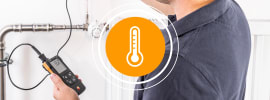- Home
- testo 317-2
testo 317-2 - Gas leak detector for new users
0632 3172
testo 317-2 - Gas leak detector for new users
0632 3172Gas pipe connections can be safely and efficiently tested with the testo 317-2 gas leak detector. The handy gas detector for new users detects two types of gas: methane and propane. The gas concentration is shown via a bar display. In addition, the gas leak detector indicates increasing gas concentrations via an acoustic alarm. The measuring instrument also confirms acoustically that it is ready for measuring.
General technical data
| Weight | < 300 g |
|---|---|
| Reaction time | t90 < 5 s |
| Operating temperature | -5 to +45 °C |
| Heat up time | 60 s |
| Battery type | 2 batteries type micro AAA 1.5 V (LR03) |
| Battery life | 4 h (LR03) |
| Display type | 8 segment trend display |
| Storage temperature | -20 to +50 °C |
Methane (CH₄)
| Measuring range | 100 to 20000 ppm |
|---|---|
| Lower response threshold | 100 ppm |
| 1st alarm limit | 10000 ppm (20% LEL) |
Propane (C₃H₈)
| Measuring range | 50 to 10000 ppm |
|---|---|
| Lower response threshold | 50 ppm |
| 1st alarm limit | 5000 ppm (20% LEL) |
Gas leak detection in gas pipes in the heated environment
Gas leak detection is the elementary testing of gas pipe parts for existing leaks. A gas pipe is considered leak-proof when there are no gas leaks from the exposed parts. This means that exposed gas pipes in particular are checked for external leak tightness. Leaks are detected by testing a connection point; e.g. at fittings, flanges, screw fittings and gas control valves. It is also important to check ducts entering buildings and gas pipes concealed in cavities at the air outlets. The application can be operated in different ways. A procedure that is still used despite its inherent danger is using a lighter to check the gas pipes. The definitely more usual and safer option is to use foaming media (leak detection foam) which produces bubbles as soon as there is a leak. The most up-to-date way to detect gas leaks is to use an electronic gas detector otherwise known as a “sniffer”.
- EU declaration of conformity testo 317-2(pdf, 33.69 kB)
- Instruction manual testo 317-2(pdf, 403.04 kB)

























